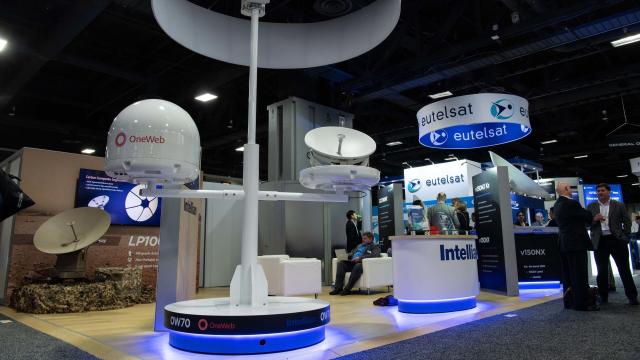One of the largest satellite internet providers to rural America, HughesNet, has entered a $US250 ($331) million, three-year contract with UK-based OneWeb to develop and manufacture ground system technology for its satellite LEO constellation, which will compete with SpaceX’s Starlink system.
According to the press release, Hughes engineers will design OneWeb’s gateways, which basically consist of on-the-ground equipment that talk to the ones in orbit and provide users with internet service — something it’s been doing since 2018. Each gateway is capable of 10,000 terminal hand-offs per second, meaning the gateways and user terminals, like someone’s computer, coordinate and schedule a satellite-to-satellite handoff in such a way that minimises latency as much as possible.
OneWeb hopes to eventually complete its constellation with a total of 48,000 satellites, which is 36,000 more that what Elon Musk has planned for SpaceX’s Starlink constellation. At the moment, its goal is hitting a total of 650 satellites in orbit by the end of 2021.
“This larger OneWeb constellation will allow for greater flexibility to meet soaring global connectivity demands,” said the company in a recent blog post.
The two companies initially announced a global distribution partnership in March 2020, with Hughes agreeing in principle to invest $US50 ($66) million in the company after OneWeb filed for bankruptcy protection the same month. The company emerged from U.S. Chapter 11 bankruptcy back in November 2020 and resumed launching satellites. Under the new agreement, Hughes has increased production on the gateway equipment and resumed testing on the installed systems. OneWeb was also the first LEO constellation to receive approval to provide connectivity services in the U.S. in 2017.
The UK-based company is currently run by a consortium of UK Government agencies (the UK Secretary of State for Business and Energy and Industrial Strategy), and Bharti Global, which have already invested $US1 ($1.4) billion into OneWeb to offer wireless broadband service. That’s a little more money than SpaceX was recently awarded from the FCC — $US885 ($1,170) million — to expand its Starlink satellite internet across the U.S. There are far more Starlink satellites than OneWeb satellites in orbit, however, 800 to 74. OneWeb has a launch planned for Friday, December 18 to send another 34 satellites into space.
Like Starlink, OneWeb’s ultimate goal is to provide global internet coverage and help close the digital divide, yet will most likely face the same challenges with regards to scale, cost, and reliability of service — not to mention creating potential light pollution that could obscure astronomers’ views of comets and whatnot. Starlink, and other ISPs like Spectrum, Cox, and AT&T could have some serious competition in the future. Not a bad thing at all considering the current state of internet in the U.S.
